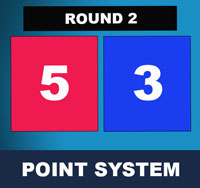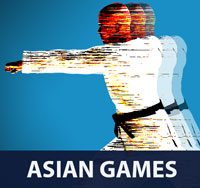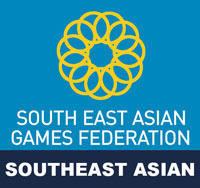- Tournaments
- World Championships
- 2013 Finals
- Female +73kg
Taekwondo 태권도Taekwondo Preschool
In some schools, permission to begin sparring is granted upon entry. The rationale for this decision is that students must learn how to deal with a fast, powerful, and determined attacker. In other schools, students may be required to wait a few months, for safety reasons, because they must first build the skills they would ideally employ in their sparring practice. View Taekwondo Sparring »




2013 World Taekwondo (WT) Championships Final | Female +73kg
As a general rule of thumb world championships will be open to elite competitors from across the world, representing their nations, and winning such an event will be considered the highest or near highest achievement in the sport
2013 World Taekwondo (WT) Championships Final | Female +73kg
City and Host Country: Puebla, Mexico 
| NAME | Olga IVANOVA | Briseida ACOSTA |
| COUNTRY | RUSSIA | MEXICO |
| FLAG |  |
 |
Advertisement


Did you know?
Impact Surface Area
Various surfaces of the body may be engaged as the blocking and striking surface depending on which area of the body is being targeted. This leads to a large array of blocking and striking positions. More information on Impact Surface Areas »
| Surface | Korean | Description | Tutorial | |
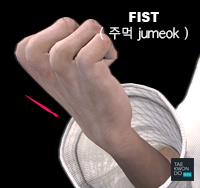 |
Fist ( 주먹 jumeok ) - is an action where a hand has the fingers curled into the palm and the thumb retracted, displaying the knuckles. |
주먹 jumeok | A fist ( 주먹 jumeok ) is an action where a hand has the fingers curled into the palm and the thumb retracted, displaying the knuckles. The act of creating a fist is known as 'making a fist' or 'clenching a fist'. | Tutorial » |
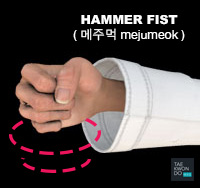 |
Hammer Fist ( 메주먹 mejumeok ) - is an action where a hand has the fingers curled into the palm and the thumb retracted, using the bottom of the hand as the striking surface. |
메주먹 mejumeok | A Hammer Fist is an action where a hand has the fingers curled into the palm and the thumb retracted, using the bottom of the hand as the striking surface. The act of creating a fist ( 주먹 jumeok ) is known as 'making a fist' or 'clenching a fist'. | Tutorial » |
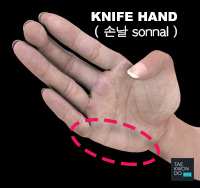 |
Hand Blade ( 손날 sonnal ) - striking surface extends with the muscle at the side of the hand located between the base of the small finger and the wrist. |
손날 sonnal | By tucking the thumb into the palm, a striking surface called the knife hand or hand blade ( 손날 sonnal ) is formed. The striking surface extends with the muscle at the side of the hand located between the base of the small finger and the wrist. | Tutorial » |
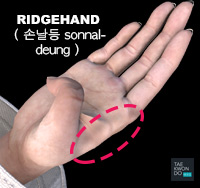 |
Ridgehand ( 손날등 sonnal-deung ) - reverse knife-hand is formed, extending a few inches along the inside of the hand below the first knuckle of the index finger. |
손날등 sonnal-deung | By tucking the thumb into the palm, a striking surface called the ridgehand ( 손날등 sonnal-deung ), or reverse knife-hand is formed, extending a few inches along the inside of the hand below the first knuckle of the index finger. | Tutorial » |
RESOURCES
This article uses material from the Wikipedia articles "Hand", "Fist (hand)", "Knife Hand", which is released under the Creative Commons Attribution-Share-Alike License 3.0.

Quiz
Question. What is the korean terminology for Elbow Target Strike?
The Elbow Target Strike is a technique that requires you to strike an imaginary target made by extending the other arm. The elbow hits the Palm ( 손바닥 sonbadak ) of the other arm and the height is around the solar plexus. In self-defense ( 호신술 hosinsool ) applications, the practitioner would reach out and grab the opponents neck ( 목 mok ).
Question. What is the korean terminology for Elbow Target Strike?
Answer you gave was: ( 표적지르기 pyojeok-jireugi )
Your answer is wrong! You need to study more!

Target Punch ( 표적지르기 pyojeok-jireugi ) is an advanced technique that requires you to strike an imaginary target made with the palm ( 손바닥 sonbadak ) of one hand with a punch ( 지르기 jireugi ). The strike ( 지르기 jireugi ) is useful for self-defense ( 호신술 hosinsool ) applications. The technique is used in the 1st Dan Black Belt Poomse ( 품새 고려 koryo ) in a Horse-Riding Stance ( 주춤서기 juchum-sogi ).
Question. What is the korean terminology for Elbow Target Strike?
Answer you gave was: ( 등주먹 앞치기 deung-jumeok-ap-chigi )
Your answer is wrong! You need to study more!

Back Knuckle Forward Strike ( 등주먹 앞치기 deung-jumeok-ap-chigi ) is an intermediate technique striking with the back knuckle ( 등주먹 deung-jumeok ). The fist should pass over from the opposite waist to the armpit, to the chin level and then hitting with the back of the fist to the opponent's face. Focus on the tightening of the muscles of the hand while you clench a fist ( 주먹 jumeok ). If the wrist ( 팔목 palmok ) bends on impact, it can easily be sprained, dislocated or broken.
View Back Knuckle Forward Strike ( 등주먹 앞치기 deung-jumeok-ap-chigi ) »
Question. What is the korean terminology for Elbow Target Strike?
Answer you gave was: ( 팔굽 표적치기 palgup-pyojeok-chigi )
Your answer is correct! Great Job!

The elbow ( 팔굽 palgup ) hits the Palm ( 손바닥 sonbadak ) of the other arm and the height is around the solar plexus. In self-defense, the practitioner would reach out and grab the opponents neck ( 목 mok ). When pulling forward the opponents neck, the practitioner would perform an elbow strike to the opponents face ( 얼굴 eolgul ) striking directly to the nose ( 코 ko ) or eyes ( 눈 nun ) as suitable targets.
Question. What is the korean terminology for Elbow Target Strike?
Answer you gave was: ( 바깥막기 momtong-bakkat-makgi )
Your answer is wrong! You need to study more!

An Outside Middle Block ( 바깥막기 momtong-bakkat-makgi ) deflects a strike away from the defender leaving an opportunity for a counterattack. For example, against a straight punch to the chest area, the block would aim to meet the forearm of the attacker, pushing the punch outwards causing it to miss, and then most commonly leaving the defender slightly to the side to counterattack the opponent.
Question. What is the name of Taegeuk #6 in Korean?
Taegeuk 태극 (in World Taekwondo (WT)) refers to a set of poomse 품새 used to create a foundation for the teaching of taekwondo. A poomse or form is a detailed pattern of defense-and-attack motions and techniques used in traditional martial arts. Each taegeuk form symbolizes a specific state thought to be indicative of the belt the student currently holds, and is represented in World Taekwondo (WT) by trigrams similar to those found in the four corners of the South Korean flag.
Question. What is the name of Taegeuk #6 in Korean?
Answer you gave was: Yuk Jang
Your answer is correct! Great Job!


The trigram associated with this poomse represents Water. Also, there is a relation to West and the relationship with a Second son. The movements of this poomse are intended to be performed like water; flowing, powerful and cleansing. Sometimes standing still like water in a lake, sometimes thriving as a river, sometimes powerful like a waterfall.
Question. What is the name of Taegeuk #6 in Korean?
Answer you gave was: O Jang
Your answer is wrong! You need to study more!


The trigram associated with this poomse represents Wind. The trigram is also related to southwest and the relationship with an eldest daughter. The I Ching promotes that wind is a gentle force, but can sometimes be furious, destroying everything in its path. As such, it is intended that this poomse is performed like the wind: gently, but knowing the ability of mass destruction with a single movement.
Question. What is the name of Taegeuk #6 in Korean?
Answer you gave was: Sa Jang
Your answer is wrong! You need to study more!


This trigram represents Thunder. Also, the trigram is strongly connected to northeast and the relationship of the Eldest son. Thunder comes from the sky and is absorbed by the earth, thus, according to the beliefs of the I Ching, thunder is one of the most powerful natural forces. This poomse is associated with power and the connection between the heavens and earth.
Question. What is the name of Taegeuk #6 in Korean?
Answer you gave was: Chil Jang
Your answer is wrong! You need to study more!


The trigram associated with this poomse represents a Mountain. Also, it represents the northwest and youngest son. The symbolism behind the mountain is the indomitable and majestic nature that all mountains possess. This poomse is intended to be performed with the feeling that all movements are this majestic due to their unconquerable nature.
Question. What is the name of Taegeuk #8 in Korean?
The trigram associated with this poomse represents the Earth. Also, there is a representation of North and Mother. The associated trigram of this poomse is Yin. Yin, here, represents the end of the beginning, the evil part of all that is good. This being the last of the poomse Taegeuk, it represents the end of the circle and the cyclic nature of the Earth.
Question. What is the name of Taegeuk #8 in Korean?
Answer you gave was: Chil Jang
Your answer is wrong! You need to study more!


The trigram associated with this poomse represents a Mountain. Also, it represents the northwest and youngest son. The symbolism behind the mountain is the indomitable and majestic nature that all mountains possess. This poomse is intended to be performed with the feeling that all movements are this majestic due to their unconquerable nature.
Question. What is the name of Taegeuk #8 in Korean?
Answer you gave was: Yuk Jang
Your answer is wrong! You need to study more!


The trigram associated with this poomse represents Water. Also, there is a relation to West and the relationship with a Second son. The movements of this poomse are intended to be performed like water; flowing, powerful and cleansing. Sometimes standing still like water in a lake, sometimes thriving as a river, sometimes powerful like a waterfall.
Question. What is the name of Taegeuk #8 in Korean?
Answer you gave was: Sam Jang
Your answer is wrong! You need to study more!


This trigram represents Fire. Related to this symbol is also East and the relationship of the Second Daughter. Fire contains a lot of energy. The symbol behind the fire is similar to the symbolism of the water in that both can aid and both can destroy. This form is intended to be performed rhythmically, with some outbursts of energy to reflect fire's rhythmic and energetic dualism.
Question. What is the name of Taegeuk #8 in Korean?
Answer you gave was: Pal Jang
Your answer is correct! Great Job!


The trigram associated with this poomse represents the Earth. Also, there is a representation of North and Mother. The associated trigram of this poomse is Yin. Yin, here, represents the end of the beginning, the evil part of all that is good. This being the last of the poomse Taegeuk, it represents the end of the circle and the cyclic nature of the Earth.
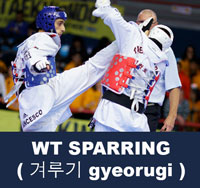


World Taekwondo (WT) Tournament Sparring ( 겨루기 gyeorugi )
Under World Taekwondo (WT) and Olympic rules, sparring is a full-contact event and takes place between two competitors in an area measuring 8 meters square. A win can occur by points, or if one competitor is unable to continue (knockout) the other competitor wins. Each match consists of three semi-continuous rounds of contact, with one minute's rest between rounds. For more information View World Taekwondo (WT) Tournament Sparring ( 겨루기 gyeorugi ) » 
Risk of injury can be reduced by completing an effective warm up consisting of a heart raiser to get your pulse up, followed by sport specific dynamic stretches (stretches whilst moving). Please follow the guidance of a certified Master Instructor or trainer when doing sports related activities. Depending on the intensity of the exercise, cooling down can involve a slow jog or walk, or with lower intensities, stretching can be used. Cooling down allows the heart rate to return to its resting rate. View more information on Warming Up and Cooling Down ».
This article uses material from the Wikipedia articles "Warming Up" and "Cooling Down", which is released under the Creative Commons Attribution-Share-Alike License 3.0.
RESOURCES
This article uses material from the Wikipedia articles "World Taekwondo Championships" and "World Championship" which is released under the Creative Commons Attribution-Share-Alike License 3.0.


